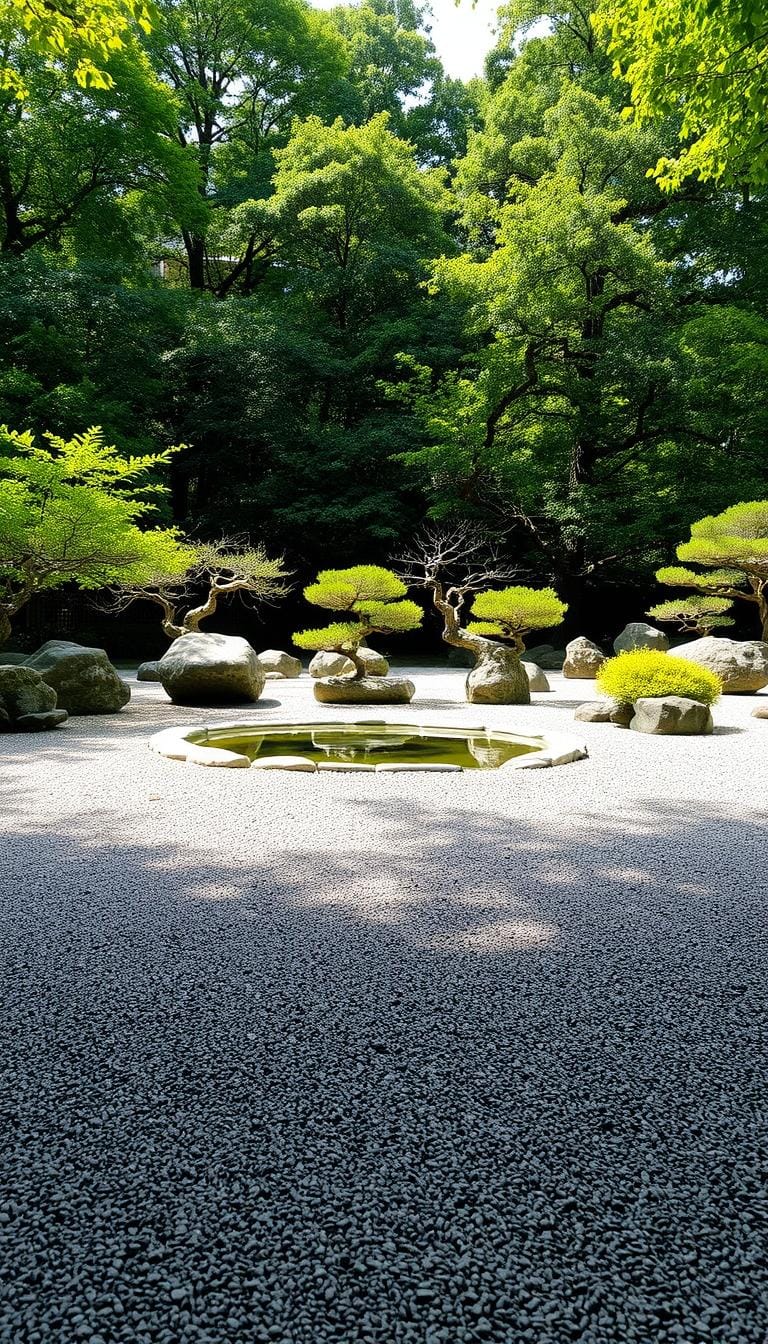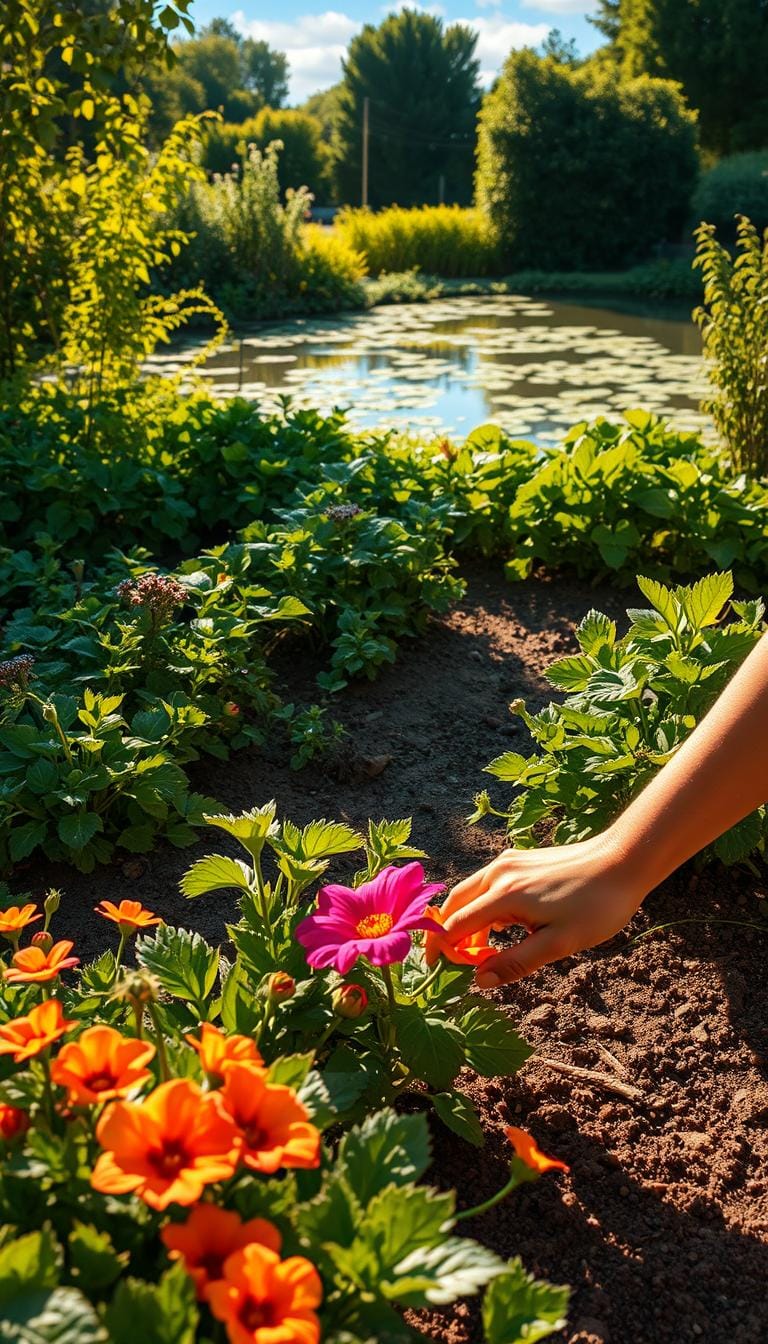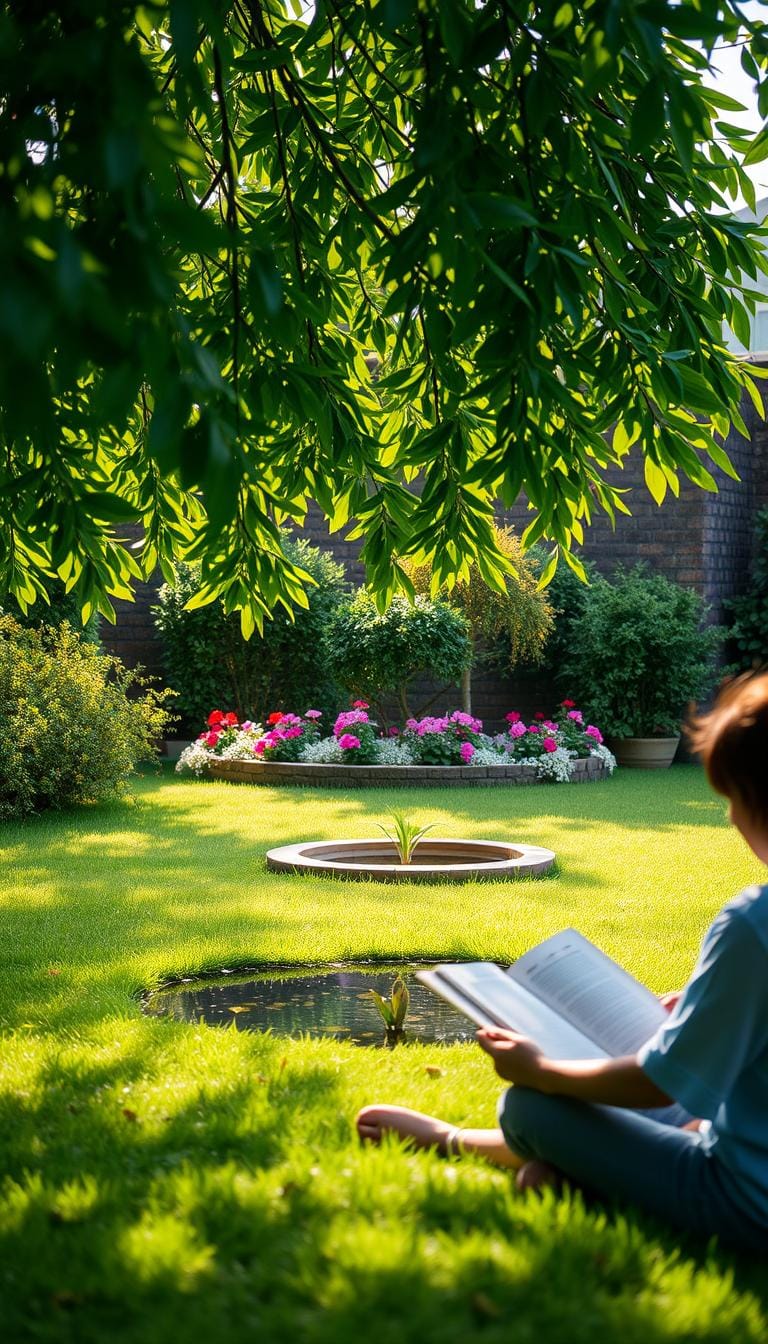Gardening to Boost Mood: How to Release Serotonin in 3 Steps
Table of Contents
For years, I’ve found happiness in gardening. It’s more than just growing plants. It’s a natural way to feel better. Digging in soil and watching seeds grow lifts my spirits.
This article will show you three easy steps to use gardening to boost your mood. We’ll talk about releasing serotonin, the brain’s natural happiness chemical.
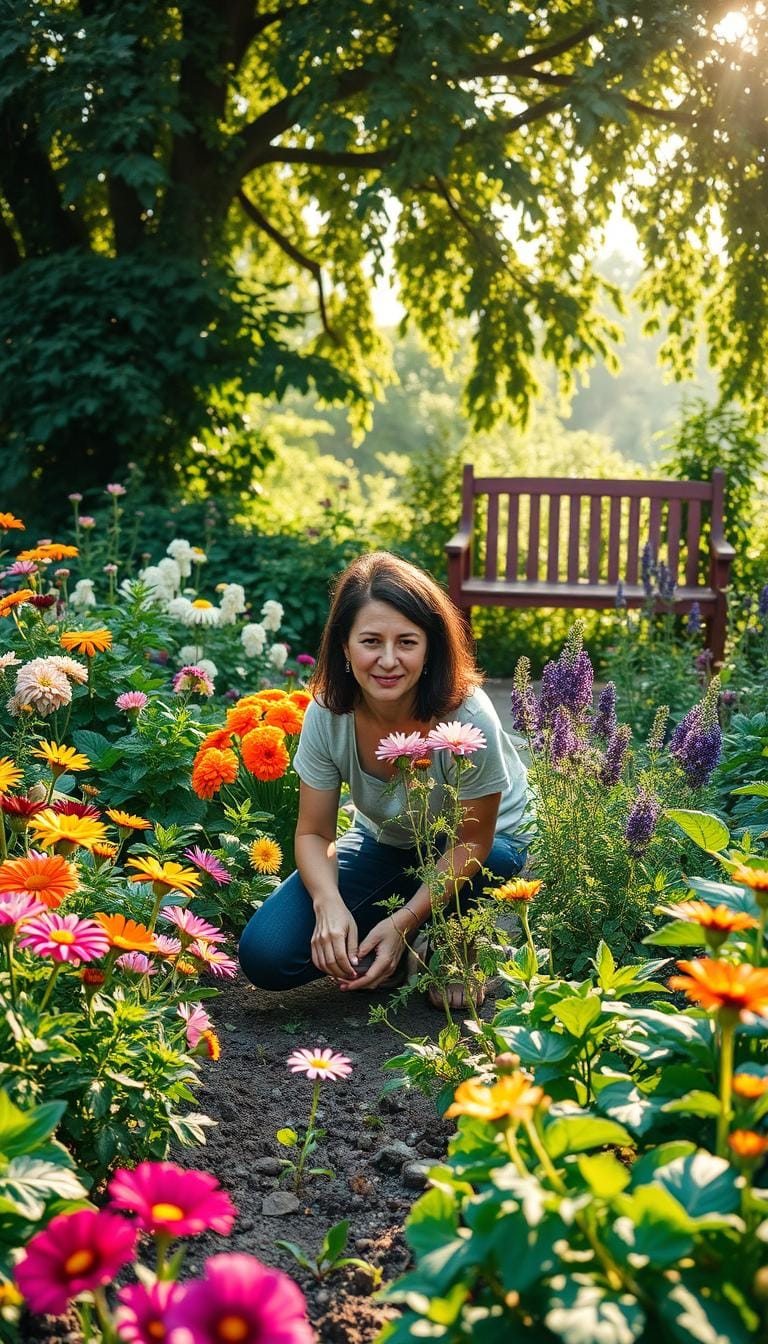
Even small tasks like planting sunflowers or watering herbs bring joy. This guide is for anyone wanting to feel better through gardening. Let’s discover how gardening can be your personal mood-boosting ritual.
Introduction: My Personal Journey with Gardening and Mood Enhancement
A few years ago, I felt stuck in a cycle of stress and doubt. One afternoon, I planted sunflower seeds in a corner of my yard. Watching them grow brought me calm. This moment started my journey with therapeutic gardening.
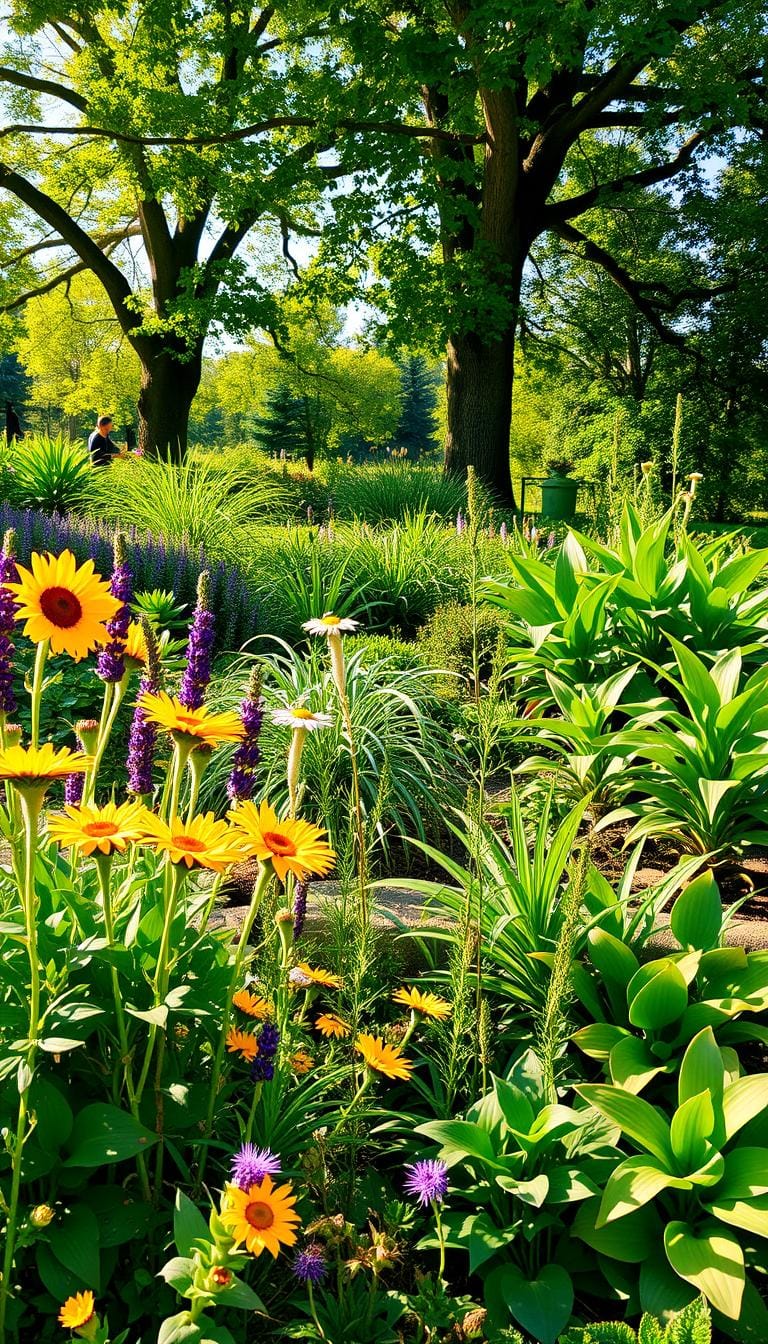
Therapeutic gardening became my daily escape. It helped me relax like nothing else. The first time I felt my anxiety fade while watering, I knew it was special.
Discovering the Therapeutic Power of Plants
Early mornings with seedlings taught me a lot. Nurturing plants is like nurturing myself. Digging in the earth was like meditation. I’d tell my tomato vines, “Grow, just like I’m trying to grow.”
“The garden doesn’t judge. It just grows.”
How Gardening Changed My Life
Before gardening, I focused on deadlines and emails. Now, success is a ripe tomato or a butterfly on lavender. My garden became a place to reset. Seasons taught me patience—roots grow before flowers.
Therapeutic gardening changed my view. It’s not just about plants; it’s a conversation between my hands and the earth. Every sprout showed me small actions can change my mind.
Embracing Gardening to Boost Mood
Starting small made all the difference. My first step was selecting mood-boosting plants known for their calming effects, like cheerful sunflowers and fragrant mint. Tending soil daily became my daily mood lifeline.

- Planting colorful blooms every spring
- Watering at dawn to watch growth unfold
- Adding herbs like basil for fresh aromatherapy
| Plant | Mood Benefits | Care Tips |
|---|---|---|
| Lavender | Reduces anxiety | Full sun, well-drained soil |
| Sunflowers | Promotes positivity | Regular watering, tall stakes |
| Marigolds | Encourages relaxation | Easy care, attracts pollinators |
Watching these mood-boosting plants thrive mirrored my own mental shift. Their growth became a daily reminder of progress. The soil’s texture, the smell of damp earth—it all grounded me in the moment. Now, every bloom is a small victory for my mental health.
Nurturing Serotonin Naturally Through Gardening
My garden isn’t just a hobby; it’s a mood booster backed by science. Sunlight, soil, and growing plants spark serotonin in the brain. Let’s explore how.
The Science Behind Serotonin Production
When I dig in the soil, sunlight warms my skin, and my hands get dirty. This triggers vitamin D production, which helps serotonin. A 2023 study in Environmental Science & Technology shows gardening boosts physical activity and releases endorphins.
Even touching soil exposes me to Mycobacterium vaccae, a bacteria that increases serotonin levels.
How My Garden Became a Source of Joy
My garden’s lavender and sunflowers are more than pretty. They’re my mental health allies. Here’s why:
- Color therapy: Bright flowers like marigolds energize my mood.
- Task rhythm: Daily watering and pruning create calming routines.
- Harvest joy: Watching seedlings grow gives me a sense of accomplishment.
A table comparing activities and their effects shows small steps matter:
| Activity | Mental Health Boost |
|---|---|
| Planting seeds | Hope and anticipation |
| Weeding | Focus and mindfulness |
| Harvesting | Gratitude and reward |
Every season teaches me that caring for plants also cares for my mind. It’s not magic; it’s biology in blooms and dirt.
Therapeutic Gardening Techniques for Emotional Well-being
Gardening isn’t just about planting flowers. It’s a mindful practice that helps calm the mind. I’ve found simple ways to make everyday tasks peaceful. Here’s what works for me:
- Slow-motion planting: I take my time with each seed, feeling the soil and sowing with care. This slows my breathing and clears my mind.
- Regular weeding routines: Daily gardening breaks help me stay focused. Seeing my garden grow boosts my confidence.
- Sensory garden design: Fragrant herbs like lavender or lemon balm make my garden a sensory delight. They help lower my anxiety.
Even 10 minutes of gardening can reset my mood. I love listening to calming music or podcasts while I work. The mix of physical activity and soothing sounds enhances my gardening experience.
Choosing plants native to my area reduces stress. Native plants are easy to care for, giving me more time to enjoy gardening. Try mixing marigolds with basil for a colorful and fragrant garden with minimal effort!
Mood-Boosting Plants and Natural Remedies
Gardening has shown me that some plants do more than look good—they make me feel better every day. Picking the right plants is essential for emotional well-being in gardening. This is supported by both my own experiences and scientific research.
My Favorite Plant Selections
| Plant | Mood Benefits | Usage Tips |
|---|---|---|
| Lavender | Calms anxiety with its scent | Plant in sunny spots; use dried buds for tea |
| Marigolds | Stimulates joy through vibrant color | Grow in borders to deter pests naturally |
| Lemon Balm | Lifts energy with citrus fragrance | Harvest leaves for mood-boosting teas |
How Specific Plants Enhance My Mood
Every plant in my garden has a special role. Lavender calms me down with its scent. Marigolds brighten my mood with their colors. Mixing lemon balm with mint makes a drink that clears my mind.
- Use lavender sprigs in pillows for better sleep
- Infuse marigold petals in oil for uplifting aromatherapy
- Chew lemon balm leaves for an instant mood lift
These choices match studies on nature’s benefits for mental health. My garden is more than a space—it’s my emotional balance tool.
Stress Relief Through Mindful Gardening Practices
When I started using garden therapy techniques, my daily tasks changed. I found calm in focused breathing while I planted or watered. Here’s how I made everyday gardening a moment of peace.
- Pause before starting. Close your eyes and take three deep breaths.
- Listen to the crunch of soil underfoot or the rustle of leaves.
- Touch plant leaves to ground your senses in the moment.
A study in the Journal of Therapeutic Horticulture showed that 15 minutes of mindful weeding can lower cortisol levels. My favorite approach combines three key garden therapy techniques:
| Technique | Benefit | Example |
|---|---|---|
| Mindful Weeding | Reduces anxiety | Sorting weeds by color while breathing slowly |
| Sensory Observation | Enhances focus | Describing leaf textures aloud |
Every time I use these methods, my mind calms down. Try them yourself—they’re free, easy to do, and backed by science. Your garden becomes a healing space, not just a place to grow plants.
Creating My Personal Serotonin-Boosting Garden Sanctuary
Starting a garden for happiness is all about planning. My garden is both useful and beautiful, making it a place of peace and connection with nature. Every part, from the paths to the plants, shows how gardening helps my mind.
Designing a Space for Relaxation
I focus on making it cozy and easy to move around. A big seating area under a pergola lets me enjoy the sun while staying cool. Soft grass paths instead of hard ones make walking barefoot a pleasure.
Adding water features like a small fountain or wind chimes brings calming sounds. They don’t make the space too loud.
Practical Tips for Garden Layout
- Layer plants strategically: Tall trees for privacy, mid-height shrubs for color, and low-growing herbs at foot level.
- Balance open and covered zones: Mix sunny spots with shaded nooks under trees or umbrellas.
- Incorporate movement: Swinging benches or hanging plants create visual interest and gentle motion.
My garden mixes science with what I like. Using native plants is good for the environment and saves me time. Every day, I check the soil and prune branches. These small steps strengthen my connection to the garden.
By designing it for myself, I’ve made a sanctuary that brings me joy every day.
Healing Effects of Gardening on My Mental Health
Starting my garden changed how I deal with stress and anxiety. Gardening is more than a hobby; it’s essential. Working with soil and plants has become my daily therapy, replacing worry with calm.
“Gardening is the cheapest therapy available.”
Here’s what changed:
- Reduced feelings of overwhelm through repetitive tasks like weeding
- Improved sleep after evening watering routines
- Greater patience as I learned to trust plant growth cycles
| Before Gardening | After Adopting Mindful Practices |
|---|---|
| Constant mental chatter | Quieter, more focused mind |
| Avoided outdoor spaces | Seek nature proactively |
| Isolated from community | Connected with local gardening groups |
Even small acts matter—like pausing to feel soil texture or noticing seedlings emerge. These moments change how we see stress. My journal shows 40% fewer low-mood days with mindful gardening. It’s not magic; it’s nature’s healing power.
Now, when anxiety hits, I grab my pruners instead of distractions. This simple change has been life-changing. My garden shows that healing grows when we care for earth and self.
Mindful Gardening: Cultivating Positivity and Happiness
Gardening is more than planting seeds. It’s a way to connect with the present moment. By mixing mindfulness with gardening, I’ve seen how small actions can change our daily lives.
“The earth has no anxiety about growing. It just grows.” — John Lennon
Techniques to Stay Present in Nature
| Technique | Benefit |
|---|---|
| Deep breathing while weeding | Reduces mental clutter |
| Observing plant growth patterns | Encourages patience |
| Sensory exploration of soil textures | Sharpens focus on the moment |
Simple Practices for Daily Mindfulness
- Set a timer for 5 minutes daily to observe sunlight patterns on plants
- Label tasks with intention: “I water this seedling to nurture life”
- Track seasonal changes in a journal
These practices make gardening a form of meditation. Even small actions like touching soil or noticing leaf colors have big effects. My garden became a place for plants and emotions to grow. Every action in the garden strengthens the connection between our minds and bodies.
Garden Therapy Techniques for Everyday Stress Relief
Gardening can make you feel better without being hard. I’ve found easy ways to make everyday tasks calm. Start with small steps, like dividing your garden into different areas.
Make a sunny spot for herbs or a shaded area with blue flowers. These spots help you feel different moods.
- Zone Design: Create areas for different things. My “Zen Zone” has pebbles and plants that love the dark. It’s great for quiet moments.
- Sensory Strolls: Walk on paths with herbs like lemon thyme or lavender. Touching leaves and smelling flowers helps me feel grounded.
- Reflective Rituals
- Write in a journal while you prune. It helps clear your mind.
- Share thanks while you water. It’s a way to appreciate your plants.
“Tending plants is like nurturing your mind—it grows stronger with care.”
Just 10 minutes of weeding or looking at flowers can calm you down. These methods have made my garden a daily therapy spot. Try doing your favorite garden tasks mindfully. It’s the simplest way to feel better.
Balancing Nature, Nurture, and Personal Growth in My Garden
Gardening is more than just plants—it’s about discipline. My daily garden routines taught me to care for myself. Each task, like watering and pruning, helps me grow personally. Therapeutic gardening shows me how small efforts lead to big results.
The Role of Routine in Garden Care
Consistent care makes gardens and lives thrive. Here’s how my routines help me grow:
- Watering daily builds discipline, like morning exercise or journaling.
- Pruning teaches release, helping me let go of stress.
- Seasonal planning keeps both garden and goals on track.
Lessons Learned from Nurturing Nature
Nature never hurries, yet everything is accomplished. — Ralph Waldo Emerson
Therapeutic gardening taught me patience. Watching seeds grow is like watching myself grow. Daily care of the soil is self-care. As my garden blooms, so does my mind. This shows that growth takes time and effort.
Conclusion
Gardening has become a daily mood booster for me. Every time I water herbs or trim flowers, I feel calmer and more focused. Science shows that caring for plants helps the brain release serotonin, lifting my spirits naturally.
Mood-boosting plants like sunflowers and rosemary are more than just colorful additions. They turn gardening into a mental health practice. Their scent and colors remind me to pause and breathe. Even small spaces, like a balcony or windowsill, can hold these life-giving plants.
Starting small changed my life. A few seeds and a pot became a habit that reshaped my mindset. I encourage you to pick one plant today—a succulent, a basil leaf, or cheerful marigolds. Tending it daily creates a simple routine that grows both your garden and your well-being. Let these plants be your quiet partners in building a happier, grounded life.
Want to explore more topics like this? Head back to the homepage for fresh insights on mental health, mindful habits, and personal growth.
Disclaimer:
This content is for informational purposes only and not a substitute for professional medical advice. Please consult a qualified healthcare provider regarding mental health concerns.

